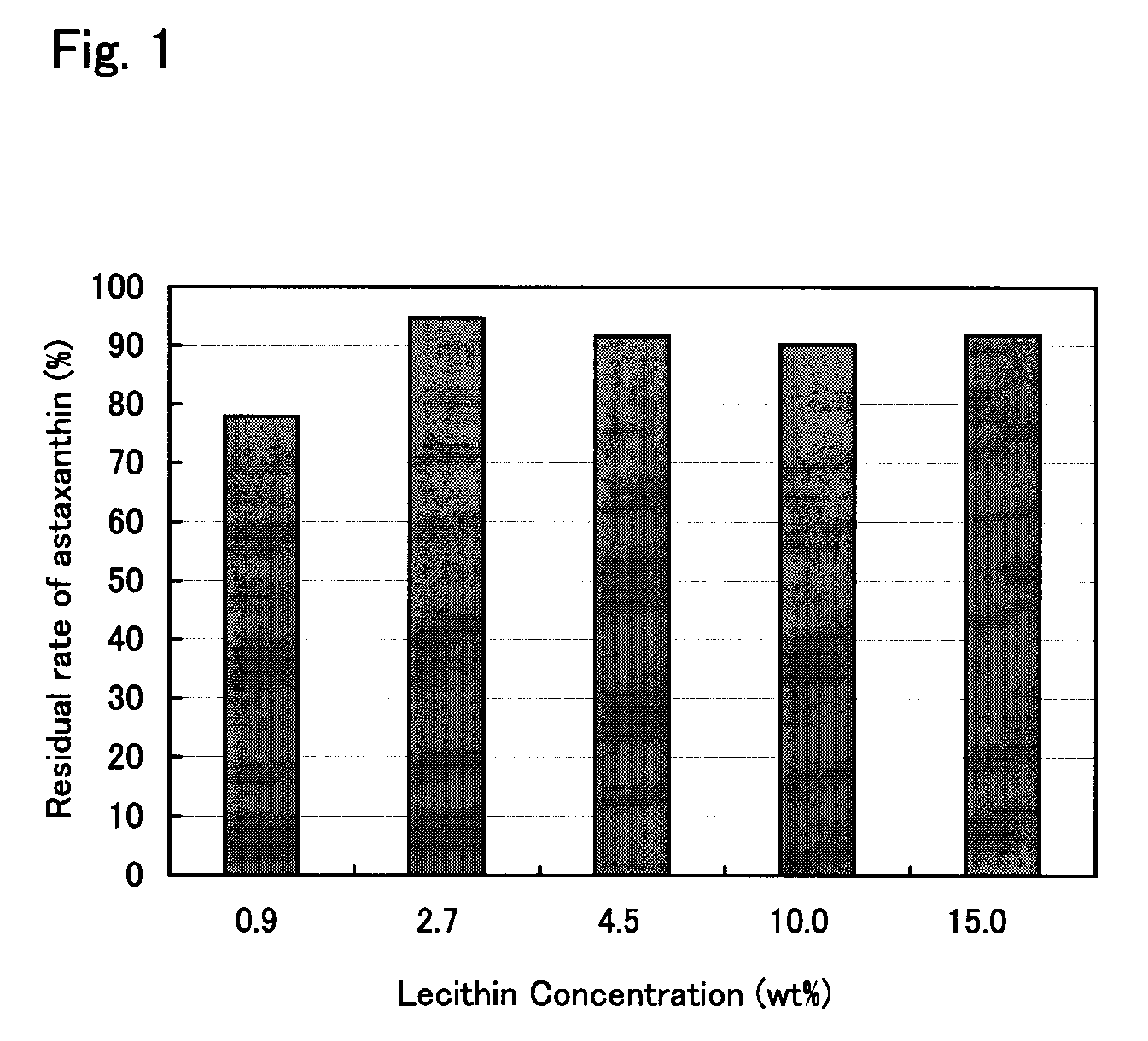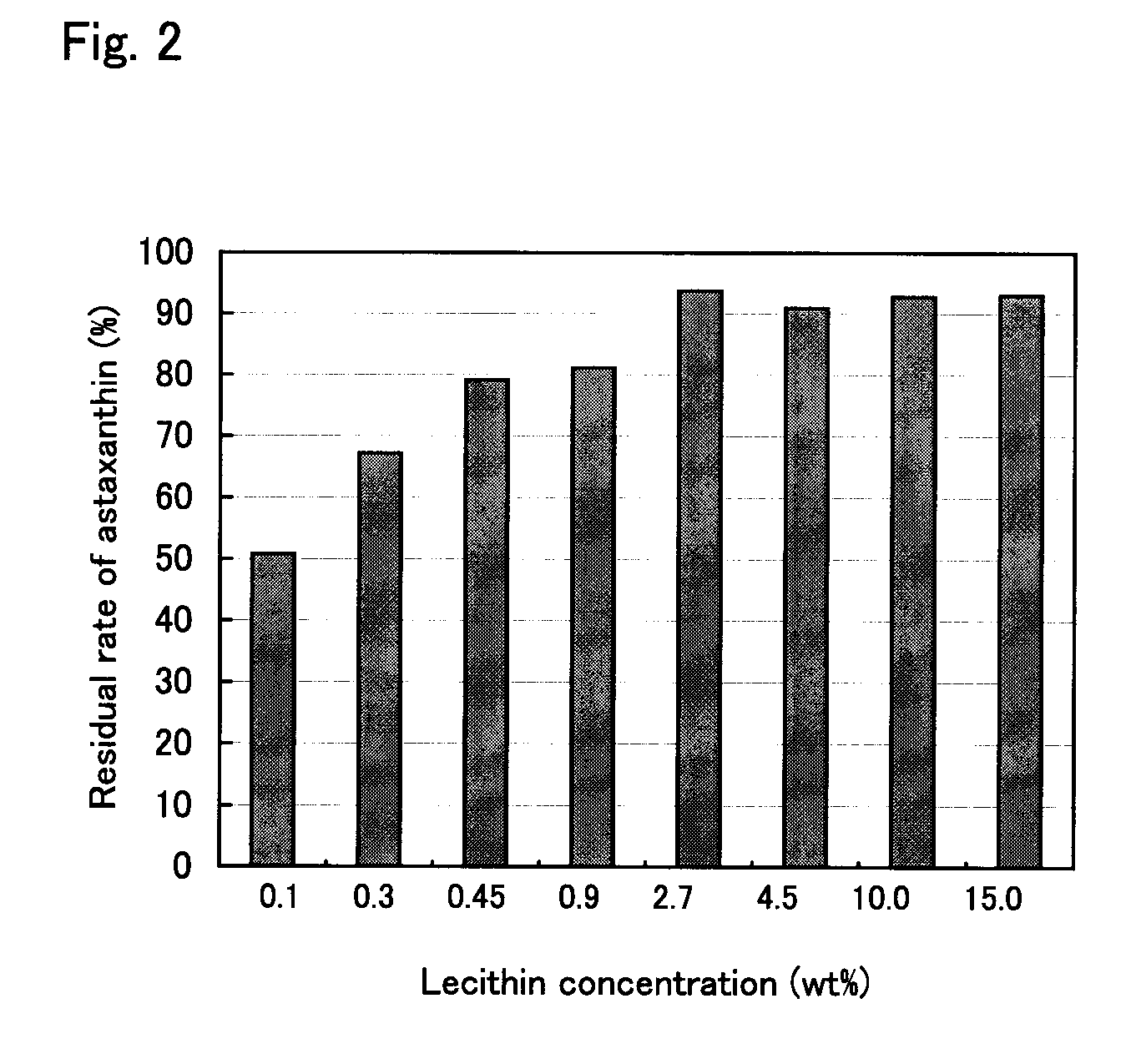Green Algal Extract Containing Astaxanthin Having High Storage Stability
a technology of astaxanthin and green algal extract, which is applied in the field of astaxanthincontaining green algal extract, can solve the problems of low yield of astaxanthin, unstable astaxanthin to heat, and contamination of extracts, and achieves the effect of increasing storage stability and simplifying the handling of extracts
- Summary
- Abstract
- Description
- Claims
- Application Information
AI Technical Summary
Benefits of technology
Problems solved by technology
Method used
Image
Examples
example 1
Preparation of Green Algal Extract—1
[0056] The Haematococcus pluvialis K0084 strain (hereinafter referred to simply as the K0084 strain), which produces astaxanthin, was used. One liter of the MBG-11 medium containing the components shown in Table 1 below was placed in a 1.5-L closed flat culture flask with a 25 mm light path, and the K0084 strain was inoculated into the medium at an initial concentration of 0.6 g / L.
TABLE 1MBG-11Componentsg / LNaNO30.41K2HPO40.04MgSO4•7H2O0.075CaCl2•2H2O0.036Citric acid (anhydrous)0.006Ammonium iron (III) citrate0.006EDTA•2Na0.001Na2CO30.02CuSO4•5H2O0.00286H3BO40.00181MnCl2•4H2O0.00022ZnSO4•7H2O0.00008Na2MoO40.000021Co(NO3)2•6H2O0.000000494
[0057] While bubbling a gas containing 3 vol % CO2 into the medium at a rate of 600 mL / min (i.e., 0.6 vvm), the culture temperature was adjusted to 25° C. and its pH adjusted to between 6 and 8, and the K0084 strain was cultivated for five days under the following conditions of light irradiation. A white fluoresc...
example 2
Examination of Phospholipid Concentration—1
[0060] Samples were prepared by adding phospholipid (lecithin from soybean, made by Wako Pure Chemical Industries Ltd.) to the green algal extract obtained in Example 1 (phospholipid: 0.9 wt %; astaxanthin: 9 wt %) so that the phospholipid concentration was 2.7 wt %, 4.5 wt %, 10 wt %, or 15 wt %, respectively. Approximately 500 mg of each sample was placed in each of two 10-mL vials, and the initial concentration of astaxanthin was measured as described above. Then, these vials were placed in an incubator set to 60° C. After storage in the incubator for one week, the astaxanthin concentration was measured again, and the residual rate was calculated. The results are shown in FIG. 1.
[0061] As seen from FIG. 1, when the green algal extract contained phospholipid at a concentration of 2.7 wt %, 90% or more of the astaxanthin remained even after one week of storage at 60° C., which is a severe condition, and when the green algal extract conta...
example 3
Examination of Phospholipid Concentration—2
[0062] A portion of the green algal extract obtained in Example 1 was diluted by a factor of two with soybean oil (made by The Nisshin OilliO Group Ltd.) to give a diluted extract containing astaxanthin at a concentration of 4.5 wt % expressed in terms of free astaxanthin. Samples were prepared from the diluted green algal extract (phospholipid: 0.45 wt %) by adding a phospholipid (lecithin from soybean, made by Wako Pure Chemical Industries Ltd.) so that the phospholipid concentration was 0.9 wt %, 2.7 wt %, 4.5 wt %, 10 wt %, or wt %, respectively. Other portions of the green algal extract obtained in Example 1 were diluted by a factor of three and by a factor of nine, respectively, with soybean oil to give diluted extracts in which the phospholipid concentration was 0.3 wt % (astaxanthin: 3 wt %) and 0.1 wt % (astaxanthin: 1 wt %), respectively. Approximately 500 mg of each sample was placed in each of two 10-mL vials, and the initial c...
PUM
| Property | Measurement | Unit |
|---|---|---|
| weight | aaaaa | aaaaa |
| weight | aaaaa | aaaaa |
| constant temperature | aaaaa | aaaaa |
Abstract
Description
Claims
Application Information
 Login to View More
Login to View More - R&D
- Intellectual Property
- Life Sciences
- Materials
- Tech Scout
- Unparalleled Data Quality
- Higher Quality Content
- 60% Fewer Hallucinations
Browse by: Latest US Patents, China's latest patents, Technical Efficacy Thesaurus, Application Domain, Technology Topic, Popular Technical Reports.
© 2025 PatSnap. All rights reserved.Legal|Privacy policy|Modern Slavery Act Transparency Statement|Sitemap|About US| Contact US: help@patsnap.com


